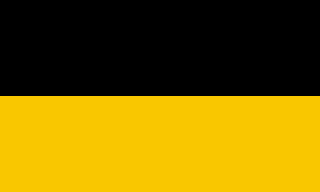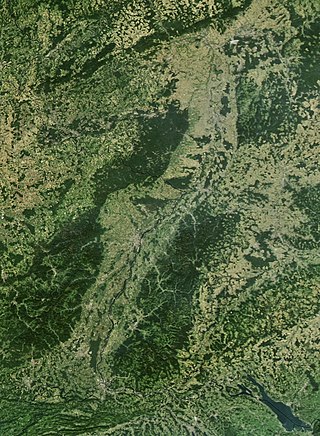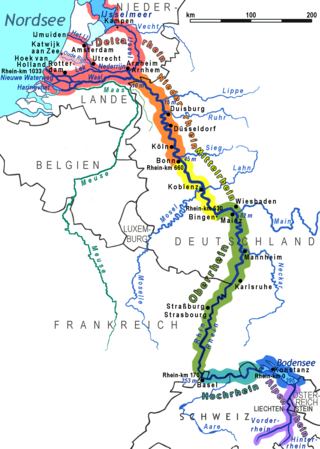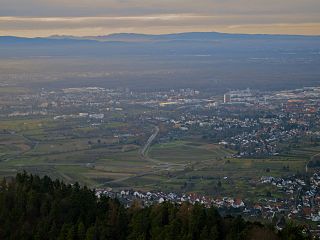
Baden-Württemberg, commonly shortened to BW or BaWü, is a German state in Southwest Germany, east of the Rhine, which forms the southern part of Germany's western border with France. With more than 11.07 million inhabitants as of 2019 across a total area of nearly 35,752 km2 (13,804 sq mi), it is the third-largest German state by both area and population. As a federated state, Baden-Württemberg is a partly-sovereign parliamentary republic. The largest city in Baden-Württemberg is the state capital of Stuttgart, followed by Mannheim and Karlsruhe. Other major cities are Freiburg im Breisgau, Heidelberg, Heilbronn, Pforzheim, Reutlingen, Tübingen, and Ulm.
The Battle of Rastatt saw part of a Republican French army under Jean Victor Marie Moreau clash with elements of the Habsburg army under Maximilian Anton Karl, Count Baillet de Latour which were defending the line of the Murg River. Leading a wing of Moreau's army, Louis Desaix attacked the Austrians and drove them back to the Alb River in the War of the First Coalition action. Rastatt is a city in the state of Baden-Württemberg in Germany, located 89 kilometers (55 mi) south of Mannheim and 94 kilometres (58 mi) west of Stuttgart.

The Upper Rhine is the section of the Rhine between Basel in Switzerland and Bingen in Germany, surrounded by the Upper Rhine Plain. The river is marked by Rhine-kilometres 170 to 529.

The Battle of Friedlingen took place on 14 October 1702, during the War of the Spanish Succession. Most of the fighting centred around Friedlingen, now a suburb of Weil am Rhein, on the border between the German state of Baden-Württemberg and Switzerland. A French force under Villars defeated an Imperial army commanded by Louis William, Margrave of Baden-Baden.

The High Rhine is the name used for the part of the Rhine that flows westbound from Lake Constance to Basel. The High Rhine begins at the outflow of the Rhine from the Untersee in Stein am Rhein and turns into the Upper Rhine in Basel. In contrast to the Alpine Rhine and Upper Rhine, the High Rhine flows mostly to the west.

University of Upper Alsace is a multidisciplinary teaching and research centre based in the two cities of Mulhouse and Colmar, France. Research and teaching at UHA concentrates mainly on science, technology, economics, management, arts and humanities. In 2017, UHA has more than 8000 students with about a hundred courses offered. The founding of UHA was driven by social and business players, among them was Jean-Baptiste Donnet.

The Grand Duchy of Baden was an independent state in what is now southwestern Germany until the creation of the German Empire in 1871. It had its own state-owned railway company, the Grand Duchy of Baden State Railways, which was founded in 1840. At the time when it was integrated into the Deutsche Reichsbahn in 1920, its network had an overall length of about 2,000 kilometres (1,200 mi).

The Baden main line is a German railway line that was built between 1840 and 1863. It runs through Baden, from Mannheim via Heidelberg, Karlsruhe, Offenburg, Freiburg, Basle, Waldshut, Schaffhausen and Singen to Constance (Konstanz). The Baden Mainline is 412.7 kilometres long, making it the longest route in the Deutsche Bahn network and also the oldest in southwest Germany. The section between Mannheim and Basle is the most important northern approach to the Swiss Alpine passes, whilst the section between Basle and Constance is only of regional significance. The stretch from Karlsruhe to Basle is also known as the Rhine Valley Railway (Rheintalbahn) and the Basle–Constance section as the High Rhine Railway (Hochrheinstrecke).

The Mannheim–Karlsruhe–Basel railway is a double-track electrified mainline railway in the German state of Baden-Württemberg. It runs from Mannheim via Heidelberg, Bruchsal, Karlsruhe, Rastatt, Baden-Baden, Offenburg and Freiburg to Basel, Switzerland. It is also known as the Rhine Valley Railway or the Upper Rhine Railway (Oberrheinbahn).

The siege of Kehl lasted from 26 October 1796 to 9 January 1797. Habsburg and Württemberg regulars numbering 40,000, under the command of Maximilian Anton Karl, Count Baillet de Latour, besieged and captured the French-controlled fortifications at the village of Kehl in the German state of Baden-Durlach. The fortifications at Kehl represented an important bridgehead crossing the Rhine to Strasbourg, an Alsatian city, a French Revolutionary stronghold. This battle was part of the Rhine Campaign of 1796, in the French Revolutionary War of the First Coalition.

At the Battle of Schliengen, the French Army of the Rhine and Moselle under the command of Jean-Victor Moreau and the Austrian army under the command of Archduke Charles of Austria both claimed victories. The village of Schliengen lies in the present-day Kreis Lörrach close to the border of present-day Baden-Württemberg (Germany), the Haut-Rhin (France), and the Canton of Basel-Stadt (Switzerland).

At the Battle of Emmendingen, on 19 October 1796, the French Army of Rhin-et-Moselle under Jean Victor Marie Moreau fought the First Coalition Army of the Upper Rhine commanded by Archduke Charles, Duke of Teschen. Emmendingen is located on the Elz River in Baden-Württemberg, Germany, 9 miles (14 km) north of Freiburg im Breisgau. The action occurred during the War of the First Coalition, the first phase of the larger French Revolutionary Wars.

In the Rhine campaign of 1796, two First Coalition armies under the overall command of Archduke Charles outmaneuvered and defeated two French Republican armies. This was the last campaign of the War of the First Coalition, part of the French Revolutionary Wars.

The Trinational Eurodistrict of Basel, or Basel metropolitan area, extends across three countries: Switzerland, France and Germany. The Trinational Eurodistrict of Basel is an organization of municipalities and cities in the trinational surroundings of Basel. The TEB acts as coordinator for cross-border projects between the German, French and Swiss cities around Basel and promotes the cultural and linguistic exchange between the people living in the region. This very close cooperation and coordination is necessary as the national borders run through a densely built area. The TEB forms an extension of the Trinational Agglomeration Basel (German: Trinationale Agglomeration Basel /French: Agglomération Trinationale de Bâle.

During the Battle of Kehl, a Republican French force under the direction of Jean Charles Abbatucci mounted an amphibious crossing of the Rhine River against a defending force of soldiers from the Swabian Circle. In this action of the War of the First Coalition, the French drove the Swabians from their positions in Kehl and subsequently controlled the bridgehead on both sides of the Rhine.

In the siege of Hüningen, the Austrians captured the city from the French. Hüningen is in the present-day Department of Haut-Rhin, France. Its fortress lay approximately 2.5 miles (4.0 km) north of the Swiss city of Basel and .5 miles (0.80 km) north of the spot where the present-day borders of Germany, France and Switzerland meet. During the time of this siege, the village was part of the Canton of Basel City and the fortress lay in area contested between the German states and the First French Republic.

The border between France and Germany has a length of 450 km (280 mi), about half of it along the Rhine.

The Second Battle of Kehl occurred on 18 September 1796, when General Franz Petrasch's Austrian and Imperial troops stormed the French-held bridgehead over the Rhine river. The village of Kehl, which is now in the German state of Baden-Württemberg, was then part of Baden-Durlach. Across the river, Strasbourg, an Alsatian city, was a French Revolutionary stronghold. This battle was part of the Rhine Campaign of 1796, in the French Revolutionary War of the First Coalition.

The Müllheim–Mulhouse railway is a 22.140 km-long single-track railway, crossing the Upper Rhine between Baden, Germany and Alsace, France. The whole line is electrified with catenary, using different national electrification standards on either side of the Rhine. It branches off the Rhine Valley Railway (Rheintalbahn) in Müllheim and it connects with the Paris–Mulhouse railway and the Strasbourg–Basel railway in Mulhouse.
EUCOR is a tri-national association of five universities in the Upper Rhine region with two universities from Germany, two from France, and one from Switzerland. It was originally founded in 1989 and was reorganised as a European Grouping of Territorial Cooperation (EGTC) in 2015.
















